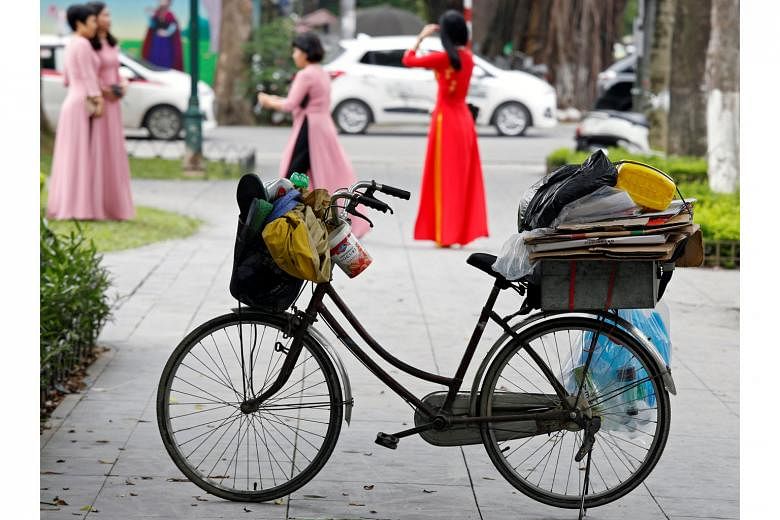"Women are the largest untapped reservoir of talent in the world," former US secretary of state Hillary Clinton once said.
Her words ring particularly true in Asia, where stereotypes and cultural norms continue to prevent millions of women from fulfilling their real potential.
This week, as representatives from 21 Asia-Pacific economies gathered for the Apec 2017 Women and the Economy Forum in Vietnam's Thua Thien-Hue province, it is an opportune time to look more closely at the status quo and some longstanding challenges in closing the gender gap.
First, some compelling figures. Despite the much-acclaimed progress of the past few decades, there are just two countries on this continent - the Philippines and Laos - that have made it to the top 50 of 144 countries ranked in the Global Gender Gap Report 2016.
It is no surprise, then, that an International Labour Organisation report this year shows East Asia and South Asia as the only two regions in the world seeing a reduction in the percentage of working women over the past decade. The situation is particularly worrisome in South Asia, where less than one-third of the female population is active in the labour market, 51 percentage points less than the rate for males.
The picture for the whole of Asia is not much brighter, according to the Asia Development Bank (ADB).
Although most working-age women in Asia wish to work, they are on average 70 per cent less likely than men to do so. The region as a whole loses an estimated US$40 billion (S$54 billion) each year as a result of gender gaps in employment and education.
Even when able to find work, women are more likely than men to be vulnerably employed, with low wages and no social protection. Last year, the percentage of women trapped in vulnerable employment was 78 per cent in South and South-west Asia and 60 per cent in South-east Asia.
As in most other regions in the world, the gender-based pay gap is another problem. According to ADB, a woman in Asia on average is paid 23 per cent less than her male counterpart. An Organisation for Economic Cooperation and Development(OECD) report in 2015 found the situation was even worse in regional economic powerhouses South Korea and Japan - the two countries with the worst-paid female employees among 35 OECD countries, with the difference being 36.6 per cent and 26.6 per cent respectively.

Factors such as low education, gender discrimination, burden of unpaid care work and limited access to financial resources have long been known to prevent women workers from achieving parity with their male counterparts.
The failure to remove these constraints is rooted in the entrenchment of social stereotypes and cultural norms in Asia, where male chauvinism is dominant and women are regarded as inferior.
In many Asian societies, girls are still told that whoever they want to become, they should first be good at housework, and fulfil their role as a family caretaker. Boys, however, are groomed for "big" work and to be the family's breadwinner.
Worse, many women in these societies believe that having males share the housework signals their failure as a woman.
In Vietnam, we have a saying that is in complete harmony with the Confucian principle of women being completely subjugated to men in the family: "As a woman, what makes you stand higher than other women is your husband."
Many Vietnamese parents still don't believe girls need to climb high up the education ladder, because the more they study, the more difficult it would be to find a husband.

Gender stereotypes also limit career choices for women all over the world. Men are often associated with jobs deemed more important and requiring more skills, like scientists, astronauts or engineers, whereas women are considered more suitable for "softer" jobs like receptionists and secretaries.
So, many women end up carrying a huge burden of unpaid care work, downplaying their capability and not daring to dream big. They lose out in higher education, quality jobs and deeper social engagement. The perception of women's capability is affected too. An ADB study in 2015 found women were perceived to have lower working skills than men.
It is evident, then, that efforts to get more women into the mainstream economy should start with challenging and dismantling deeply ingrained stereotypes.
Concrete steps should be taken early, at home, in schools, and in communities so that boys learn to appreciate, even look up to women, and understand that caregiving and housework are natural tasks for both sexes. Girls should be taught to treasure themselves, to chase dreams bigger than traditional roles as wives and mothers.
These are fundamental changes that might take some time, but they are indispensable.
Measures with immediate impact should be implemented as well. Greater investment in public services should lead to quality childcare and care for the elderly. Policies on parenting should boost men's role in childbirth and childcare, providing badly needed relief to overburdened women.
The private sector can certainly play a major role in improving women's access to financial support, technology and business advice, given that a large proportion of micro, small and medium-sized enterprises in the Asia-Pacific region are led by women.
For example, just last week in Vietnam, Facebook partnered with governmental agencies to launch a project supporting women entrepreneurs with investment, technology development, training and capacity building. This is a model that should be promoted.
Despite the obstacles, Asia does not lack role models of successful women in all fields and initiatives.
The political figure who led the delegation of southern communist forces at the Paris Peace Conference held to end the Vietnam War was a woman, Madam Nguyen Thi Binh.
Japan's Professor Masayo Takahashi this year performed the world's first induced pluripotent stem cell-derived transplant into humans, revitalising hopes of a new way of treatment for damaged organs. Ms Manasi Pradhan is leading a nationwide movement to end violence against Indian women.
In business, Asia has some sterling role models too. Hong Kong's Ms Zhou Qunfei is the richest self-made woman in the world, according to Forbes. Vietnam's Ms Nguyen Thi Phuong Thao has become South-east Asia's first self-made woman billionaire and one of the country's two billionaires.
Chinese business tycoon Jack Ma once said women were the "secret sauce" behind his firm's success.
We should recognise that women are the "secret sauce" for the success of families around the world and, therefore, of all nations. And they should be given their due, in the form of equality in the workplace, and equal access to opportunities to advance their lot.
- This is a series of columns on global affairs written by top editors and columnists from members of the Asia News Network and published in newspapers and websites across the region.


